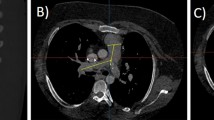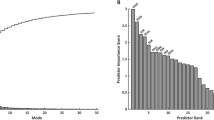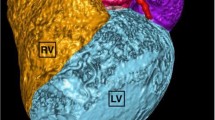Abstract
Purpose
Approximately 5.7 million people in the US are affected by congestive heart failure. This study aimed to quantitatively evaluate cardiothoracic morphology and variability within a cohort of heart failure patients for the purpose of optimally engineering cardiac devices for a variety of heart failure patients.
Methods
Co-registered cardiac-gated and non-gated chest computed tomography (CT) scans were analyzed from 20 heart failure patients (12 males; 8 females) who were primarily older adults (79.5 ± 8.8 years). Twelve cardiothoracic measurements were collected and compared to study sex and left ventricular (LV) ejection fraction (EF) type differences in cardiothoracic morphology.
Results
Four measures were significantly greater in males compared to females: LV long-axis length, LV end diastolic diameter (LVEDD) at 50% length of the LV long-axis, the minimal distance between the sternum and heart, and the angle between the LV long-axis and coronal plane. Four measures were significantly greater in patients with reduced EF compared to preserved LV: LV long-axis length, LVEDD at 50% length of the LV long-axis, left ventricular volume normalized by body surface area, and the angle between the mitral valve plane and LV long-axis.
Conclusions
These cardiothoracic morphology measurements are important to consider in the design of cardiac devices for heart failure management (e.g. cardiac pacemakers, ventricular assist devices, and implantable defibrillators), since morphology differs by sex and ejection fraction.






Similar content being viewed by others
References
Alberta, H. B., T. Takayama, T. C. Smits, B. B. Wendorff, R. P. Cambria, M. A. Farber, et al. Aortic arch morphology and aortic length in patients with dissection, traumatic, and aneurysmal disease. Eur. J. Vasc. Endovasc. Surg. 50(6):754–760, 2015. https://doi.org/10.1016/j.ejvs.2015.08.005.
Asferg, C., L. Usinger, T. S. Kristensen, and J. Abdulla. Accuracy of multi-slice computed tomography for measurement of left ventricular ejection fraction compared with cardiac magnetic resonance imaging and two-dimensional transthoracic echocardiography: a systematic review and meta-analysis. Eur. J. Radiol. 81(5):e757–e762, 2012. https://doi.org/10.1016/j.ejrad.2012.02.002.
Bak, S. H., S. M. Ko, H. J. Jeon, H. S. Yang, H. K. Hwang, and M. G. Song. Assessment of global left ventricular function with dual-source computed tomography in patients with valvular heart disease. Acta Radiol. 53(3):270–277, 2012. https://doi.org/10.1258/ar.2011.110247.
Bennett, C. J., J. J. Maleszewski, and P. A. Araoz. CT and MR imaging of the aortic valve: radiologic-pathologic correlation. Radiographics 32(5):1399–1420, 2012. https://doi.org/10.1148/rg.325115727.
Blair, J. E., M. Huffman, and S. J. Shah. Heart failure in North America. Curr. Cardiol. Rev. 9(2):128–146, 2013.
Coats, A. J. The “muscle hypothesis” of chronic heart failure. J. Mol. Cell Cardiol. 28(11):2255–2262, 1996. https://doi.org/10.1006/jmcc.1996.0218.
Geleijnse, M. L., P. M. Fioretti, and J. R. Roelandt. Methodology, feasibility, safety and diagnostic accuracy of dobutamine stress echocardiography. J. Am. Coll. Cardiol. 30(3):595–606, 1997.
Gordon, E. P., I. Schnittger, P. J. Fitzgerald, P. Williams, and R. L. Popp. Reproducibility of left ventricular volumes by two- dimensional echocardiography. J. Am. Coll. Cardiol. 2(3):506–513, 1983.
Gruner Svealv, B., G. Fritzon, and B. Andersson. Gender and age related differences in left ventricular function and geometry with focus on the long axis. Eur. J. Echocardiogr. 7(4):298–307, 2006. https://doi.org/10.1016/j.euje.2005.06.008.
Halon, D. A., J. Ayman, R. Rubinshtein, B. Zafrir, M. Azencot, and B. S. Lewis. Cardiac computed tomography angiographic findings as predictors of late heart failure in an asymptomatic diabetic cohort: an 8-year prospective follow-up study. Cardiology 138(4):218–227, 2017. https://doi.org/10.1159/000478995.
Hayes, A. R., F. S. Gayzik, D. P. Moreno, R. S. Martin, and J. D. Stitzel. Abdominal organ location, morphology, and rib coverage for the 5(th), 50(th), and 95(th) percentile males and females in the supine and seated posture using multi- modality imaging. Ann. Adv. Automot. Med. 57:111–122, 2013.
Heo, W., H. K. Min, D. K. Kang, H. J. Jun, Y. H. Hwang, and H. C. Lee. Three different situations and approaches in the management for anomalous origin of the right coronary artery from the left coronary sinus: case report. J. Cardiothorac. Surg. 9:21, 2014. https://doi.org/10.1186/1749-8090-9-21.
Ho, S. Y., and P. Nihoyannopoulos. Anatomy, echocardiography, and normal right ventricular dimensions. Heart 92(Suppl I):i2–i13, 2006.
Iwano, H., and W. C. Little. Heart failure: what does ejection fraction have to do with it? J. Cardiol. 62(1):1–3, 2013. https://doi.org/10.1016/j.jjcc.2013.02.017.
Lam, C. S., P. Gona, M. G. Larson, J. Aragam, D. S. Lee, G. F. Mitchell, et al. Aortic root remodeling and risk of heart failure in the Framingham Heart study. JACC Heart Fail. 1(1):79–83, 2013. https://doi.org/10.1016/j.jchf.2012.10.003.
Lu, M. T., H. Ersoy, A. G. Whitmore, M. J. Lipton, and F. J. Rybicki. Reformatted four-chamber and short-axis views of the heart using thin section (</=2 mm) MDCT images. Acad. Radiol. 14(9):1108–1112, 2007. https://doi.org/10.1016/j.acra.2007.05.019.
Nishimura, R. A., C. M. Otto, R. O. Bonow, B. A. Carabello, J. P. Erwin, 3rd, R. A. Guyton, et al. 2014 AHA/ACC guideline for the management of patients with valvular heart disease: executive summary: a report of the American College of Cardiology/American Heart Association Task Force on Practice Guidelines. Circulation 129(23):2440–2492, 2014. https://doi.org/10.1161/cir.0000000000000029.
Owan, T. E., D. O. Hodge, R. M. Herges, S. J. Jacobsen, V. L. Roger, and M. M. Redfield. Trends in prevalence and outcome of heart failure with preserved ejection fraction. N. Engl. J. Med. 355(3):251–259, 2006. https://doi.org/10.1056/NEJMoa052256.
Rajiah, P., and P. Schoenhagen. The role of computed tomography in pre-procedural planning of cardiovascular surgery and intervention. Insights Imaging. 4(5):671–689, 2013. https://doi.org/10.1007/s13244-013-0270-8.
Raman, S. V., M. Shah, B. McCarthy, A. Garcia, and A. K. Ferketich. Multi-detector row cardiac computed tomography accurately quantifies right and left ventricular size and function compared with cardiac magnetic resonance. Am. Heart J. 151(3):736–744, 2006. https://doi.org/10.1016/j.ahj.2005.04.029.
Rizvi, A., R. C. Deaño, D. P. Bachman, G. Xiong, J. K. Min, and Q. A. Truong. Analysis of ventricular function by CT. J. Cardiovasc Comput. Tomogr. 9(1):1–12, 2015. https://doi.org/10.1016/j.jcct.2014.11.007.
Shuman, W. P., K. R. Branch, J. M. May, L. M. Mitsumori, D. W. Lockhart, T. J. Dubinsky, et al. Prospective versus retrospective ECG gating for 64-detector CT of the coronary arteries: comparison of image quality and patient radiation dose. Radiology 248(2):431–437, 2008. https://doi.org/10.1148/radiol.2482072192.
Stark, J. The use of valved conduits in pediatric cardiac surgery. Pediatric Cardiol. 19(4):282–288, 1998. https://doi.org/10.1007/s002469900311.
The Criteria Committee of the New York Heart Association. Nomenclature and criteria for diagnosis of diseases of the heart and great vessels. 9th ed. Boston: Little, Brown, 1994.
Zile, M. R., J. S. Gottdiener, S. J. Hetzel, J. J. McMurray, M. Komajda, R. McKelvie, et al. Prevalence and significance of alterations in cardiac structure and function in patients with heart failure and a preserved ejection fraction. Circulation 124(23):2491–2501, 2011. https://doi.org/10.1161/CIRCULATIONAHA.110.011031.
Acknowledgments
The authors thank Caresse Hightower, Katelyn Greene, Elizabeth Lopez, Jennifer Dawkins, Casey Costa, and Xin Ye for their assistance with data collection. This work was supported by Medtronic [W-000617], and a National Science Foundation REU Site grant [Award No. 1559700].
Animal Studies
No animal studies were carried out by the authors for this article.
Conflict of interest
Ashley A. Weaver report grants from Medtronic and the National Science Foundation during the conduct of the study. Ryan Lahm is an employee of Medtronic plc. Mona Saffarzadeh, James P. Gaewsky, Joshua Tan, Bharathi Upadhya, and Geoffrey T. Jao declare no conflict of interest.
Human Studies/Informed Consent
All procedures followed were in accordance with the ethical standards of the responsible committee on human experimentation (institutional and national) and with the Helsinki Declaration of 1975, as revised in 2000 (5). The study complied with Institutional Review Board policies approved by Wake Forest University.
Author information
Authors and Affiliations
Contributions
Study concept and design: Ryan Lahm, Ashley A. Weaver. Acquisition of data: Mona Saffarzadeh, James P. Gaewsky, Joshua Tan, Ashley A. Weaver. Analysis and interpretation: Mona Saffarzadeh, James P. Gaewsky, Bharathi Upadhya, Geoffrey T. Jao, Ryan Lahm, Ashley A. Weaver. Study supervision: Ryan Lahm, Ashley A. Weaver.
Corresponding author
Additional information
Associate Editor Gautam Kumar oversaw the review of this article.
Publisher's Note
Springer Nature remains neutral with regard to jurisdictional claims in published maps and institutional affiliations.
Electronic supplementary material
Below is the link to the electronic supplementary material.
Rights and permissions
About this article
Cite this article
Saffarzadeh, M., Gaewsky, J.P., Tan, J. et al. Cardiothoracic Morphology Measures in Heart Failure Patients to Inform Device Designs. Cardiovasc Eng Tech 10, 543–552 (2019). https://doi.org/10.1007/s13239-019-00436-z
Received:
Accepted:
Published:
Issue Date:
DOI: https://doi.org/10.1007/s13239-019-00436-z




